During the entire existence of the Earth constantly appeared some new animals, and which is dying out. This process never stopped. But the most distinguished five periods, when our planet was deprived of a variety of plants and animal species. These periods are called mass extinctions. In total there are five stages of mass extinctions of animals on Earth.
The most famous is completely destroyed the dinosaurs, but it was not the greatest disaster. The biggest extinction Earth has deprived 95% of all animals, but has enabled the emergence of new species that have formed the modern Zoosfery.
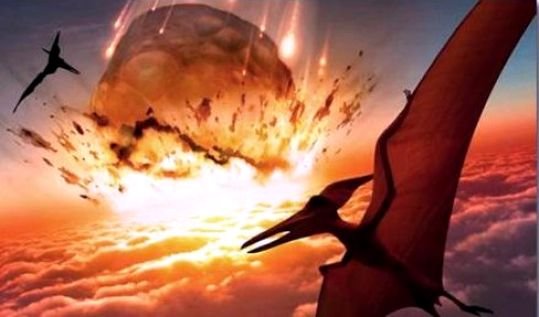
1. Ordovician-Silurian extinction events.
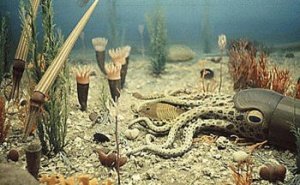
Died out about 60% of all marine invertebrates.
The very first mass extinction occurred about 450-440 million. Years ago. You can not call the exact cause of the extinction, but most scholars are inclined to believe that the reason was the movement of Gondwana - a vast supercontinent that included almost the entire land of the Earth. Gondwana moved close to the south pole of the planet, which has led to global cooling, and as a consequence, a fall in sea level.
Most of the animals at the time lived in the water, and the drop in world sea levels destroy or damage the habitats of most species Ordovician and Silurian period.
2. Late Devonian extinction.
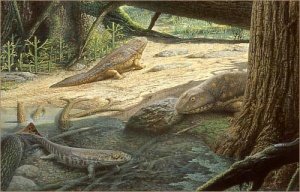
Died out about 50% of marine animals.
There was 374 and 359 million. Years ago. Late Devonian extinction consisted of two peaks, during which the Earth has lost 50% of the existing genera and nearly 20% of all families. During the Devonian extinction disappeared almost all jawless (up to the present day survived only lampreys and hagfish).
It is unclear what caused this mass extinction. The basic version of the incident - a change in sea level and ocean oxygen depletion. Perhaps this was due to high volcanic activity of the Earth. Some scientists also do not rule out a large drop of extraterrestrial bodies such as comets.
3. Great Permian extinction.
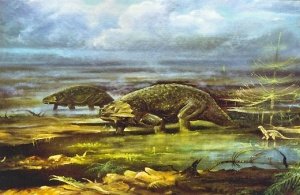
The disappearance of 95% of all animal species.
This is the mass extinction, has ever happened on this planet. Some scientists call the Permian extinction - the greatest mass extinction of all time. Around 250 million. Years ago, disappeared 70% of all land animals. In the ocean, it fared even worse - lost 96% of marine species. During the Great Perm extinction killed more than 57% of births insects. This is the only known extinction, which affected insects.
Extinction has affected even the microorganisms, which seemingly has little to do harm.
One opinion, why it happened such a massive extinction, scientists have no. Some are inclined to believe that was the whole reason for the increased volcanic activity. Some suggest that the ocean floor a lot of methane were released (see. Frozen methane on the ocean floor), which led to disastrous climate change. Some scientists believe that at this time the Earth collided with a huge asteroid. Proof of the latter theory is a huge crater in Antarctica (Wilkes is on the Earth).
After the Permian extinction fauna recovered 30 million. Years (some scientists believe that the biosphere restoration lasted 5 million. Years). Widely distributed animals that have been in the shadow of more powerful forms. So, this time, is a period of formation of archosaurs (the ancestors of modern crocodiles and extinct dinosaurs). From them came and poultry, which could have been avoided if not for the great Permian extinction.
4. Triassic extinction.
50% of the animals died out.
Triassic-Jurassic extinction event happened 200 million. Years ago. Lost about 20% of all marine animals, a lot of archosaurs (became widespread after the Permian extinction), and most species of amphibians. Scientists estimate that half of all known animals living at the time, died during the Triassic extinction.
A feature of the Triassic extinction is considered transience. It happened over 10 thousand. Years, which is very fast on a planetary scale. At this time it began to unravel sverhkontinenta Pangaea into separate continents. Perhaps that was the reason for the collapse of a large asteroid, which changed the weather on the planet, causing the extinction. But the evidence for this theory is not so far found no large crater triarskogo period.
Some scientists believe that the cause of the Triassic extinction, as well as all the other mass extinctions of animals, is to increase the volcanic activity of the Earth at the time.
5. Cretaceous-Paleogene extinction event.
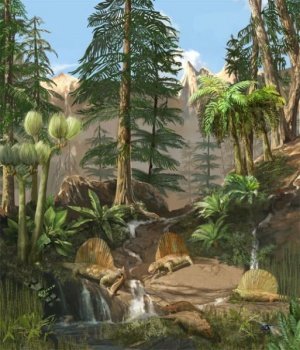
Became extinct more than 15% of all animals.
The most famous extinction occurred about 65 million. Years ago. Noted is the fact that at this time on the Earth dinosaurs. Just lost more than 15% of families of marine animals and 18% of families of terrestrial animals.
Until the end it is not clear what led to this mass extinction. Scientists continue to study the Cretaceous and Paleogene period of the Earth to find the cause of the disaster. The most prominent theory is that the Earth collided with a large asteroid or fell into the radiation zone of the supernova explosion.
But in addition to "space" reasons, there is speculation that dinosaurs (as well as some other species) simply could not adapt to the new vegetation violent development was observed at the time, and a "poisoned" inedible leaves. Or they were exterminated first mammal, which destroyed the dinosaurs masonry, preventing them from multiplying. In favor of the latter theory is the fact that some dinosaurs lived for quite a long time on the territory of present-day North America and India, where possible, "dangerous" mammals appeared later.
i found this, right here on steemit:
https://steemit.com/books/@carlitashaw/the-silent-ecocide-a-crisis-of-human-consciousness it discusses the sixth mass extinction, now underway.
I made a short documentary about it last year, which you might like, articulating the World Scientists' Warning to Humanity, a Second Notice, with programmed digital voices and moving pictures.
Join the #ExtinctionRebellion